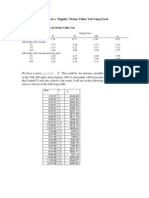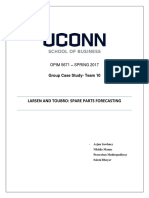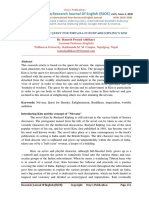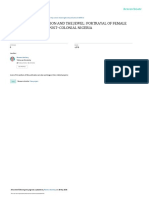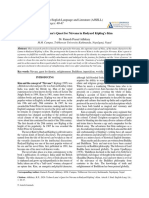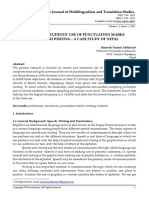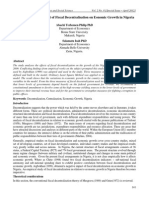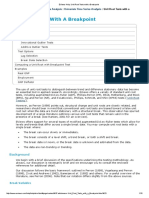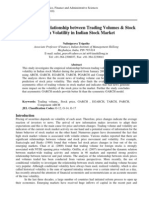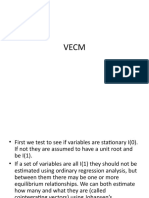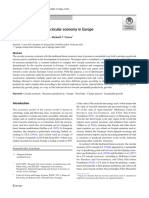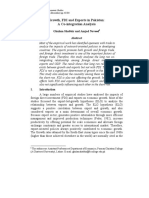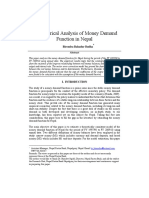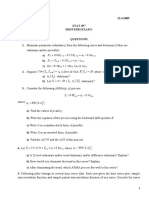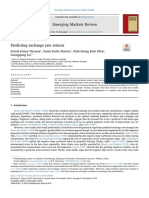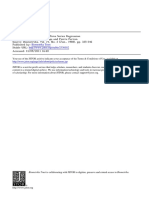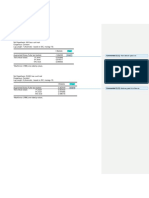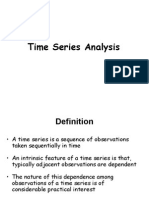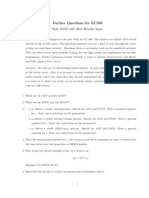5 Subas Gautam
5 Subas Gautam
Uploaded by
RameshCopyright:
Available Formats
5 Subas Gautam
5 Subas Gautam
Uploaded by
RameshOriginal Title
Copyright
Available Formats
Share this document
Did you find this document useful?
Is this content inappropriate?
Copyright:
Available Formats
5 Subas Gautam
5 Subas Gautam
Uploaded by
RameshCopyright:
Available Formats
ISSN: 2961-1989
Academia Research Journal
Volume: 3 Issue: 1, Year 2024
******************************
Correlation between Foreign Direct Investment and Economic Growth in Nepal
Subas Gautam1
1
Assistant Professor, Department of Economics, Tribhuvan University, Mahendra Multiple Campus,
Nepalgunj
1
Corresponding Author: subasgau@gmail.com DOI: https://doi.org/10.3126/academia.v3i1.61258
Article History: Received: Oct. 14, 2022 Revised: Nov. 15, 2023 Received: Dec 10, 2023
Abstract
Nepal's strategic location between India and China, coupled with favorable market access and
lower tariffs, presents an enticing prospect for foreign investors. Despite these advantages, the
nation faces challenges, including a fragile financial sector, bureaucratic hurdles, and political
instability, hindering substantial Foreign Direct Investment (FDI). This study investigates the
correlation between FDI and economic growth in Nepal, recognizing the critical role of FDI in
the country's development. The goal of the study is to examine the linear relationship between
these factors while analyzing the trajectory and structure of foreign direct investment and
economic growth in Nepal. Among the specific goals are looking at FDI inflow by sector,
assessing the link between FDI and economic growth, and developing theories based on these
goals. The research design is explorative, descriptive, and analytical, employing time series data
from FY 1994 to 2021. Data is sourced from government bodies like NRB, MOF, MOI, and
CBS, and econometric tools are applied for analysis. Limitations include reliance on secondary
data and a study period of 25 years. The study underscores the need for an investor-friendly
environment to attract foreign investments and addresses the challenge of accumulating capital
domestically. Recognizing the indispensable role of FDI in Nepal's economic development, the
study provides insights for policymakers and recommends investment-friendly policies to
promote FDI inflows and contribute to economic growth.
Keywords: economic growth, market access, bureaucratic hurdles, investor-friendly
environment, foreign direct investment
Introduction
The economic growth of emerging nations has been significantly influenced by foreign
direct investment (FDI), which has a history of oscillating in response to changes in investment
climates, governmental regulations, and more general economic frameworks. This dynamic has
been evident since the 1950s, encompassing phases such as import substitution, natural resource-
led development, structural adjustment, and the transition to market economies, with the private
sector gaining prominence in the 1990s.
FDI is widely defined by the International Monetary Fund (IMF) as the acquisition of a
significant stake in a foreign firm. More specifically, it refers to businesses in which non-
residents own at least 25% of the voting share capital; this is a crucial sign of globalization. FDI
RMC, MMC, Nepalgunj, ARJ | 48
ISSN: 2961-1989
Academia Research Journal
Volume: 3 Issue: 1, Year 2024
******************************
occurs when a foreign investor buys assets in another nation with the intention of managing
them. FDI, which is acknowledged as a crucial component of globalization, provides limited
management and talent, enhanced marketing expertise, and channels for non-traditional exports
in addition to finance and technology.
According to the World Investment Report (UNCTAD, 2018), global FDI flows
experienced a 23 percent decline in 2017, with developing economies stabilizing at US$671
billion. Developing Asia, retaining its status as the largest FDI recipient, received US$476
billion. However, least developed countries (LDCs) witnessed a 17 percent drop in FDI flows,
raising concerns among policymakers regarding the indispensable role of international
investment in sustainable industrial development.
Sharma (2009) emphasizes FDI as a principal complement to domestic investment and
capacity building in LDCs. FDI, uniquely packaged with resources like capital, technology,
skills, and management know-how, contributes to income, employment, and capacity building in
the host economy. These benefits go beyond the quick returns on investment for multinational
organizations; they also create connections and knock-on effects that improve the capacities of
local businesses and human capital.
Adhikari (2013) underscores Nepal's subsistence economy, limited domestic market, and
the need for capital mobilization to exploit existing resources for economic growth. Challenges,
including population growth, poverty, and external shocks like the 2015 earthquake and Indian
blockades, have underscored the vulnerability of Nepal's economy. Bista (2010) asserts that FDI
is a major source of capital and knowledge, facilitating industrialization and international
business expansion. FDI promotes foreign commerce, strengthens institutions and human
resources, and encourages domestic investment, all of which support economic progress in
emerging nations. Nepal's Regulatory Environment: Based on the Foreign Investment and
Technology Transfer Act, 1992, Gautam and Prasain (2006) describe Nepal's foreign investment
legislation. The influence of FDI on the nation's economic development has been little, despite
efforts to encourage it.
The study aims to comprehensively analyze the historical evolution of FDI in developing
countries, with a focus on Nepal. By examining global trends, the role of FDI in LDCs, Nepal's
economic context, post-disaster impacts, and the regulatory environment, the research aims to
provide insights into the intricate relationship between FDI and economic development in the
Nepalese context.
Statement of the Problem
Nepal, strategically positioned between the emerging nations of India and China, holds
considerable appeal for foreign investors. Enjoying unrestricted access to the Indian market and
boasting lower tariffs on imported raw materials and components compared to other South Asian
countries, Nepal presents an enticing prospect. The nation's diverse climate, natural resources,
and terrain offer numerous untapped opportunities, particularly in sectors such as tourism,
energy, light manufacturing (apparel), and mineral deposits. While Nepal has managed to attract
modest foreign direct investment (FDI) in these niche areas, the impact on employment
RMC, MMC, Nepalgunj, ARJ | 49
ISSN: 2961-1989
Academia Research Journal
Volume: 3 Issue: 1, Year 2024
******************************
generation has been limited, primarily concentrated in low-technology, labor-intensive
production. Despite the liberalization of FDI laws in 1992, persistent obstacles hinder investors,
and Nepal faces challenges in meeting the minimum FDI requirements.
Several weaknesses contribute to this situation, including a fragile financial sector,
inefficient administrative functions, government mandates, geographical constraints, policy
instability, bureaucratic insecurity, unclear investment policies, political instability, corruption,
and a lack of corporate governance. The frequent movements and disruptions caused by parties,
including the Maoists, pose threats to bilateral and multilateral development projects. The critical
challenge for Nepal is establishing an investor-friendly business climate that complements its
relatively small bureaucracy, a crucial factor in attracting foreign investment.
Given these complexities, accumulating capital resources domestically becomes a
genuine challenge. Recognizing the indispensable role of foreign investment in the country's
economic growth and development, a comprehensive assessment of the reasons behind the
declining FDI becomes imperative.
Research Questions
The investigation is guided by the following research questions:
i. What is the pattern of Nepal's economic development and inflow of foreign direct
investment by sector?
ii. How does Nepal's economic development correlate with foreign direct
investment?
Objectives for the Research
The main objective of this research is to examine the connection between Nepal's
economic expansion and foreign direct investment. The following are the specific objectives:
i. Analyzing Nepal's economic development and foreign direct investment trend and
structure.
ii. ii. To examine the connection between Nepal's economic expansion and foreign
direct investment.
Literature Review
Foreign direct investment (FDI) has distinct purposes: market-seeking for access to
foreign markets and resource-seeking for securing natural resources. The impact of FDI on
economic growth is debated. Neoclassical economists argue it positively affects growth if it
influences technology permanently. The endogenous growth model sees FDI as crucial for
human capital, technology transfer, and organizational advancements, fostering growth.
Modernization theory suggests FDI fuels growth through capital accumulation, while
dependency theory contends heavy reliance on foreign investment may hinder growth, leading to
foreign dominance and stagnant development in developing countries.
RMC, MMC, Nepalgunj, ARJ | 50
ISSN: 2961-1989
Academia Research Journal
Volume: 3 Issue: 1, Year 2024
******************************
Chitrakaar (1994) conducted an extensive examination of Foreign Direct Investment
(FDI) in Nepal, drawing cross-country references from the SAARC region. Utilizing both
primary and secondary sources, the study analyzed the trends and forms of foreign investment,
its determinants, the facilities and incentives offered to attract it, and the reasons for the subdued
flow of FDI in Nepal. Despite the adoption of more liberal policies and promised facilities and
incentives, Chitrakaar found that the influx of foreign investment in Nepal remained less
impressive than that of neighboring countries.
Pyakuryal (1995) focused on the impact of economic liberalization on attracting foreign
investment in Nepal. The study aimed to assess the effects of economic liberalization on various
sectors of the economy, relying on secondary data published by different government agencies.
Pant and Sigdel (2004) investigated the existing hurdles in attracting FDI in Nepal,
employing annual data from 1988 to 2003 and an economic model for analysis. The study
identified attracting FDI as a challenging task, especially for small countries with limited
resources and undeveloped infrastructure like Nepal. The authors recommended policy measures
to counterbalance competition and emphasized learning from the experiences of other
developing countries.
FNCCI (2005) portrayed Nepal as attracting significantly less FDI inflow, providing data
on joint ventures, the present economic situation, legal provisions, and useful information for
foreign investors. The report aimed to offer prospective investors insights into the overall
investment climate in the country.
Gautam and Prasain (2006) acknowledged the initiation of Joint Ventures (JVs) and
Multinational Companies (MNCs) in Nepal in the early 1980s. The Foreign Investment and
Technology Act of 1982 aimed at achieving high economic growth and narrowing the saving-
investment gap. The authors perceived foreign investment as essential for reducing foreign debt,
fostering economic stability, and national security. However, they noted that Nepal's proportion
of foreign investment to total GDP was less than one percent, emphasizing the need for a more
liberal FDI policy.
Regmi (2009) found that FDI significantly contributed to economic growth in Nepal by
supplementing domestic savings and investment, facilitating essential imports for industrial
growth, and maintaining expenditure on education and health services. FDI was credited with
providing skill manpower, technical skills, and organizational ability.
Sharma (2009) underlined that foreign direct investment (FDI) offers a plethora of novel
technology, management strategies, funding, and market access to facilitate the production and
distribution of products and services. The report did point out that there are obstacles to
overcome before Nepal can foster foreign direct investment (FDI), which calls for cooperation
from leaders in industry, politics, and bureaucracy.
Bista (2010) outlined some conditions of FDI in Nepal, noting that most investments
were small, and investors were predominantly individuals rather than companies. The study
RMC, MMC, Nepalgunj, ARJ | 51
ISSN: 2961-1989
Academia Research Journal
Volume: 3 Issue: 1, Year 2024
******************************
highlighted that approximately 40 percent of FDI in Nepal was Indian, given the open border and
historical links between the two countries.
Pokhrel (2010) identified a long-term relationship between variables and suggested a
weak positive relationship between FDI and the Gross Domestic Product (GDP) growth rate in
Nepal. The study also indicated non-stationarity in the levels of the variables and a long-run
equilibrium relationship among them.
Risal (2010) explained that while Nepal had implemented market-oriented reforms and
promoted FDI, the benefits from global economic integration through FDI were yet to be fully
realized. The study noted that foreign firms were involved in import-substitution activities, often
motivated by tariff differentials between Nepal and India.
Dangal (2011) examined the nature, necessity, and scope of foreign direct investment
(FDI) in Nepal, evaluating policy, regulations, and other relevant factors. The study, which drew
support from primary and secondary sources, showed that free-market incentives and reforms
notwithstanding, Nepal's foreign investment landscape remains bleak. The study showed that
under liberal policies, FDI into Nepal increased significantly.
Pokhrel (2011) examined the relationship between FDI and GDP, acknowledging that
while the marginal effect may not be significant due to autocorrelation, FDI inadequately
describes GDP without it. The study recognized the weakness of not providing a representative
picture of the overall FDI and GDP situation in Nepal and highlighted the use of data from 1983
to 2007 only.
Jha, Agrawal, Gupta, and Mishra (2012) studied FDI determinants in six South Asian
countries, finding positive impacts of trade openness, GDP, and direct investment on FDI, with
labor having a negative influence. The study emphasized South Asia's attractiveness for business
process outsourcing and cost-effective mass manufacturing due to cheaper labor.
Thapa (2013) detailed the government's intention to impose additional requirements on
international companies wishing to register as cargo brokers in Nepal. Given the crucial role that
foreign investors play in the cargo industry, the Department of Industry sought to impose an
investment cap and mandate that foreigners bring in new technology.
Adhikari (2013) highlighted Nepal's potential for both market-seeking and resource-
seeking investors, with opportunities in hydropower, travel and tourism, infrastructure projects,
and various industries. The study emphasized the need for a hospitable investment climate to
attract foreign investors.
Timilsina and Mahato (2014) explained that FDI serves as a means of industrialization in
Nepal, attracting capital, technology, and expertise. The study highlighted the importance of
foreign investment in diversifying the economy, emphasizing the shortage of these factors in
Nepal.
RMC, MMC, Nepalgunj, ARJ | 52
ISSN: 2961-1989
Academia Research Journal
Volume: 3 Issue: 1, Year 2024
******************************
Despite these contributions, a research gap exists in synthesizing these findings to
comprehensively understand the evolving dynamics and impediments of FDI and its impact on
economic growth in Nepal.
Research Methodology
Research Design
This study uses an exploratory, descriptive, and analytical research approach with the
goal of examining the linear relationship between FDI inflows and Nepal's economic growth.
The conceptual framework of the study uses variables that were gathered chronologically from
different government agencies to go from data gathering to empirical analysis. Following data
collection, econometric techniques are used for additional analysis.
Sample Size
The data span from FY 1994 to 2021, encompassing a total of 25 years of observations
collected from diverse government entities such as the National Reserve Bank (NRB), Ministry
of Finance (MOF), Ministry of Industry (MOI), and Central Bureau of Statistics (CBS) in Nepal.
The study's sample size includes 25 years of observations, collected from multiple government
bodies like CBS, NRB, MOF, and MOI.
Nature and Source of the Data
This research adopts a descriptive, analytical, and statistical approach, with data in time
series format from fiscal year 1994 to 2021. Data on Approved FDI, Actual FDI, percentage
changes in GDP growth rate and FDI inflow, sector-wise information, etc., are sourced from
government bodies such as NRB, MOF, MOI, and CBS. Logarithmic transformation methods are
applied to the collected data when necessary.
Limitations of the Study
Primarily conducted for academic purposes, this study acknowledges certain limitations in
terms of data and statistical tools:
Reliance on secondary data for analysis and interpretation, making the accuracy
contingent on the reliability of available information.
The study covers a limited period of 25 years from FY 1995/96 to 2022/21 due to the
moderate time series sample.
Methods of Data Collection
In economics, both primary and secondary methods are prevalent for data collection.
Primary methods involve sampling (both systematic and random) and non-sampling or total
enumeration methods. Secondary methods entail the collection of data from authorized sources,
whether published or unpublished.
RMC, MMC, Nepalgunj, ARJ | 53
ISSN: 2961-1989
Academia Research Journal
Volume: 3 Issue: 1, Year 2024
******************************
Model Specification
Spanning from FY 1995 to 2021, this study utilizes time series data to assess the impact
of FDI on Nepal's economic growth through linear empirical modeling. The preferred model is a
simple linear regression, specifically ordinary least squares. Following the verification of the
basic asymptotic properties of the time series data, the study applies further econometric model
selection. The dependent variable is real gross domestic product (RGDP), while the independent
variables consist of real foreign direct investment (RFDI) and real gross capital formation
(RGCF), expressed in the economic modeling equation: RGDP = F(RFDI, RGCF). The aim is to
determine relationships that are both meaningful and statistically significant.
Results and Analysis
Trend and Structure of Foreign Direct Investment in Nepal
This section delves into the trends and structure of Foreign Direct Investment (FDI) and
economic growth in Nepal, analyzed by sector, year, and country-wise categorization of FDI
inflow and economic growth spanning fiscal year 1995/96 to 2020/21.
Over the last 25 years, the trend in FDI and economic growth in Nepal has exhibited
fluctuations, primarily influenced by political stability and peace—a prerequisite for attracting
substantial FDI. Nepal's economy has grappled with issues like political instability and structural
constraints, hindering its ability to attract a significant FDI inflow. Comparative statistics
indicate that Nepal's FDI remains relatively small compared to other South Asian countries. Data
reveals the approval of 206 FDI projects, with a total investment of 265 million at the end of
2020/21. Noteworthy contributions come from joint ventures with India, China, the USA, Japan,
Germany, and South Korea, with China's joint ventures constituting 12 percent of the total FDI.
Despite being rich in natural and human resources, Nepal has not optimally utilized these
assets. Foreign investment and technology transfer play a crucial role in steering the national
economic system towards self-dependency, fostering resilience, dynamism, and competitiveness
through optimal resource utilization. This enhanced business culture significantly contributes to
economic development by expanding industrial development and internal revenue.
Trend of Foreign Direct Investment and Economic Growth
FDI is regarded as a source of economic development and modernization. The table
below illustrates the percentage change in foreign direct investment and the percentage change in
Gross Domestic Product in Nepal from fiscal year 1995/96 to 2020/21.
RMC, MMC, Nepalgunj, ARJ | 54
ISSN: 2961-1989
Academia Research Journal
Volume: 3 Issue: 1, Year 2024
******************************
Table 1
Percentage Change in GDP and FDI Inflow in Nepal
Fiscal Percentage change in Percentage change in actual FDI in
Year Economic growth Nepal
1995/96 3.47 17.5
1996/97 5.33 67.7
1997/98 5.05 34.2
1998/99 3.02 34.7
1999/00 4.41 16.4
2000/01 6.20 -1.1
2001/02 4.80 -23.3
2002/03 0.12 53.6
2003/04 3.95 -
2004/05 4.68 8.3
2005/06 3.48 -18.0
2006/07 3.36 11.4
2007/08 3.41 3.0
2008/09 6.10 29.2
2009/10 4.53 31.3
2010/11 4.82 64.0
2011/12 3.42 128.8
2012/13 4.67 45.8
2013/14 3.53 15.9
2014/15 6.01 6.5
2015/16 3.98 38.8
2016/17 0.43 88.8
2017/18 8.98 31.4
2018/19 7.62 51.3
2019/20 6.66 51.1
2020/21 -2.37 60.6
Sources: (MOF Nepal 2021)
Table 1 asserts the percentage (%) change in GDP growth rate is the percentage (%)
change in Net FDI inflow is presented from fiscal 2005/06 to 2021. In 2005 the GDP
growth rate is 3.48 and FDI inflow is -18.0 %. The highest economic growth rate is 8.98
% in 2017 and lowest economic growth rate is -2.37 % in 2020. The highest FDI inflow is
128.8 % in the fiscal year 2011 and lowest FDI inflow is -18.0 % in 2005. In fiscal year
2017 to 2019 there is positive relation between Net FDI inflow and Economic growth rate.
In last two years the net FDI inflow is increasing but the GDP growth rate is decreases.
Year wise Approval and Actual FDI inflow in Nepal.
RMC, MMC, Nepalgunj, ARJ | 55
ISSN: 2961-1989
Academia Research Journal
Volume: 3 Issue: 1, Year 2024
******************************
Foreign direct investment FDI is an important sources of finance for many countries
including Nepal butt the trend and structure of year wise flow of foreign direct investment
in Nepal is erratic and unpredictable. The approval and Actual foreign direct investment in
Nepal is presented by following table
Table 2
Year Wise Approval and Actual FDI Inflow in Nepal
Fiscal year Approval FDI Actual FDI
1995/96 2219.9 388.0
1996/97 2395.5 1621.0
1997/98 2000.3 685.0
1998/99 1666.4 578.0
1999/00 1417.6 233.0
2000/01 3002.6 -33.0
2001/02 1209.7 -282.3
2002/03 1793.8 961.4
2003/04 2764.8 -
2004/05 1635.8 136.0
2005/06 2606.3 -469.4
2006/07 3186.0 362.3
2007/08 9812.6 293.9
2008/09 6255.1 1829.2
2009/10 9100.0 2852.0
2010/11 10053.2 6437.1
2011/12 7138.3 9195.4
2012/13 19818.7 9081.9
2013/14 20132.4 3194.6
2014/15 67455.0 4382.6
2015/16 15254.3 5920.9
2016/17 15206.5 13503.9
2017/18 55760.5 17504.6
2018/19 25484.4 13065.2
2019/20 37805.8 19478.7
2020/21 32172.8 19512.7
Sources NRB/MOICES (2021)
Table 2 presents the approval and Actual Net foreign direct investment since 2005 to 2021.
In fiscal year 2005/06 the approval FDI is 2606.3 million and actual Net FDI is -469.7 million.
The approval and actual foreign direct investment is increasing up to the fiscal year 2007/08. In
Fiscal year 2014/15 the approval FDI is 67455.0 million and Actual net FDI is 4832.
RMC, MMC, Nepalgunj, ARJ | 56
ISSN: 2961-1989
Academia Research Journal
Volume: 3 Issue: 1, Year 2024
******************************
6million.Which is the greatest amount of approval FDI inflow in the history of Nepal. Since the
fiscal year 2014/15 to 2016/17 the approval and actual FDI was decreasing. The approval and
actual FDI is not satisfactory in fiscal year 2020/21 as compare to the previous year.
Sector wise foreign direct investment in fiscal year 2078/79
One of the main drivers of a nation like Nepal's economic growth is foreign direct
investment. Every year, foreign direct investment rises in a variety of economic sectors. A table
is used to list some of the important sectors below.
Table 3
Sector Wise Foreign Direct Investment in Nepal
Sector of the economy No. of projects
Agro and forest based 4
Energy based 1
ICT based 6
Information 4
Manufacture 37
Minerals 0
Service 73
Tourism 81
Total 206
Sources MOI 2078/79
Table 3 shows sector wise number of projects and FDI inflow in fiscal year 2078/79. The
FDI inflow is higher in tourism and service sector where 81 projects are running in tourism and
73 projects are running in service sector. In total 206 projects, the FDI inflow is not satisfactory
in agro and forest based industry, energy and ICT based sectors.
Country wise foreign direct investment in fiscal year 2078/79
Foreign direct investment is a category of cross-border investment. Nepal has
received FDI from different countries in fiscal year 2078/079.
Table 4
County wise FDI inflow in Nepal
Country Amount in (Rs crore)
China 1970
RMC, MMC, Nepalgunj, ARJ | 57
ISSN: 2961-1989
Academia Research Journal
Volume: 3 Issue: 1, Year 2024
******************************
India 991
USA 154
South-Korea 128
Japan 33
UK 77
Switzerland 30
Canada 33
Singapore 75
British vergin Tapu 111
Sources MOF 2022
Table 4 explore about the country wise flow of FDI in Nepal in fiscal year 2078/079. China
is the largest foreign direct investor with NRP 1970 crore and followed by India NRP 991 crore,
USA is 154 and South-Korea is 128 crore respectively. It shows higher FDI inflow in Nepal from
Asian continent than other continent.
FDI inflow in Nepal from south Asian countries in 2020/21
Nepal is one of the member of SAARC. Where there are eight member countries. The
reason behind establishment of SAARC is to establish mutual relationship between south Asian
countries and financial co-operation. The FDI inflow in Nepal from south Asian countries are
presented below.
Table 5
FDI Inflow from South Asian Countries
Country Amount in (US$ Billion)
Afghanistan 0.02
Bangladesh 2.9
Bhutan 0.0
India 44.7
Maldives 0.4
Pakistan 2.1
Sri-lanka 0.6
Sources CBS Nepal 2021
The table 5 shows south Asian countries and FDI inflow in Nepal. Where India is the largest
foreign direct investor country with NRP 44.7 Billion. Bangladesh stands at second position with
NRP 2.9 Billion. Bhutan is not interested to invest in Nepal in the form foreign direct investment.
RMC, MMC, Nepalgunj, ARJ | 58
ISSN: 2961-1989
Academia Research Journal
Volume: 3 Issue: 1, Year 2024
******************************
Descriptive Statistics of the variables
The following table displays descriptive data on real gross domestic product (RGDP),
foreign direct investment (FDI), and real government expenditure (RGCE). It includes
information on mean, median, maximum and lowest values, standard deviation, skewness, and
other factors.
Table 6
Descriptive Statistics of the Variables
RGDP FDI RGCE
Mean 411135.3 669168.4 53.22378
Median 366224.7 280513.0 57.02000
Maximum 949885.8 3458793 112.8800
Minimum 143079.6 16601.00 10.55000
228022.4 32.29987
Standard Deviation 889055.7
Skewness 0.659096 1.629933 0.095763
Kurtosis 2.368299 4.729584 1.741178
Jarque-Bera 4.006272 25.53410 3.039964
Probability 0.134912 0.000003 0.218716
Sum 1850108 30112573 2395.070
Observations 25 25 25
Certain variable data are regularly distributed, whereas others are not, as demonstrated by
descriptive statistics of variables. Thus, the results of regression may be manipulated by
employing this data.
Stationary Test
To verify the co-integration between real GDP and FDI, the Engle-Granger co-integration
model must first determine whether or not the data utilized for the regression analysis are stable.
The initial step in converting non-stationary data into stationary data is essential. When time series
RMC, MMC, Nepalgunj, ARJ | 59
ISSN: 2961-1989
Academia Research Journal
Volume: 3 Issue: 1, Year 2024
******************************
data are stationary, it indicates that their mean, variance, and auto covariance (at different lags)
are constant throughout time; in other words, they are time invariant.
The study uses the Augmented Dickey Fuller (ADF) test to verify the Stationary test. The
methodology chapter provides an explanation of the unit root test detail model.
Table 7
Augmented Dickey Fuller Tests for Unit Root
Variables Level Form First Difference Remarks
(in log)
Intercept Trend and Intercept Trend and
Intercept Intercept
LnRGDP 0.9636 -3.1825 -7.4697 -7.6005 I (1)
(0.99) (0.14) (0.00)* (0.00)*
LnRFDI 0.164485 -2.187053 -7.32282 -7.239424 I (1)
(0.96) (0.48) (0.00)* (0.00)*
LnRGCE -1.5126 -0.6606 -5.1350 -5.1414 I (1)
(0.51) (0.96) (0.00)* (0.00)*
Source: Author’s Calculation through EViews.10.
Note: ⃰ shows 1% level of significance; ** shows 5% level of significance and numeric value in
the parenthesis expresses p-values. The p-values are based on MacKinnon (1996) one-sided p-
values.
The ADF test statistics for the relevant research variable are displayed in the table. At the
level, every variable is non-stationary, but at the first difference, they are all stationary. All of
the variables are stationary at the 1% level of significance at first difference, according to the
enhanced Dickey Fuller tests. It follows that every variable is integrated of order 1, or I (1).
Since every variable is stable at initial difference, the Engle Granger technique is used in this
study to examine the variable's long-term co-integration.
Granger Co-Integration Test and Model of Error Correction
The Engle-Granger co-integration test states that the stationary of the residual term error
correlation term in the long run model may be assessed in order to determine the long run co-
integration of the variables. The study looks for a relationship between RGDP and FDI. The long-
term models were developed using the OLS technique, as shown below.
Table 8
Long run model result by using OLS Method
RMC, MMC, Nepalgunj, ARJ | 60
ISSN: 2961-1989
Academia Research Journal
Volume: 3 Issue: 1, Year 2024
******************************
Dependent Variable: LNGDP
Variable Coefficient Std. Error t-Statistic Prob.
LFDI 0.1250* 0.03485 3.5890 0.0014
LnRGCE 0.2000* 0.00245 3.6678 0.0012
C 10.8771 0.35141 30.7160 0.0000
R-squared = 0.900763 F-statistic = 113.4617
Adjusted R-squared = 0.89285 Prob(F-statistic) = 0.000000
Sum squared residual = 0.3160 Durbin-Watson stat = 1.8725
Source : Authors own calculation through EViews.10
Note: */**/*** denotes statistically significant at 1 percent, 5 percent, 10 percent
The long run model and the so-called long run coefficient are displayed in Table 8. In order
to assess the long-term coefficient between the variables, the residual term must be stable. To do
it, we must verify the residual term's stationary state. There is a long-term link between the variable
and the long-run model if the long-run model's residual is stationary at level. Thus, the model is
not erroneous. ADF verifies the residual's stationary test.
Table 9
ADF Test Result of Residual of First Model
Null Hypothesis: ECT has a unit root
Exogenous: None
F t-Statistic Prob.*
Augmented Dickey-Fuller test statistic -5.407393 0.0000
1% level -2.618579
5% level -1.948495
Test critical value
10% level -1.612135
*MacKinnon (1996) one-sided p-values.
Source: Authors calculation through EViews-10.
Table 9 displays the residual ADF test result. At the 5% percentile of significance, the
Augmented Dickey-Fuller test statistics table value of 5.381876, as shown in Appendix VII, is
higher than the crucial Engle-Granger co-integration value of 4.700. The ECT is stationarity at
level, i.e., the null hypothesis that the ECT has a unit root is rejected. As a result, the residual
RMC, MMC, Nepalgunj, ARJ | 61
ISSN: 2961-1989
Academia Research Journal
Volume: 3 Issue: 1, Year 2024
******************************
term is stable at level form, indicating that the variables have co-integration and that the long-
term model won't be misleading.
Findings
The following is a summary of the study's main conclusions:
1. According to the results of the Augmented Dickey-Fuller (ADF) test, all of the variables used
in this study are integrated of order 1 (I(1)), with stationarity appearing only after the first
difference.
2. The results of the Engle-Granger co-integration test support the long-run Ordinary Least
Squares (OLS) model's immunity to spurious regression by demonstrating the co-integration of
the variables utilized in this investigation.
3. Although this association is not significant in the near term, the analysis finds a substantial
long-term relationship between Real Gross Domestic Product (RGDP) and Foreign Direct
Investment (FDI). The long-run model shows that, when all other parameters are held constant, a
one percent increase in FDI leads to a 0.12 percent rise in RGDP.
4. The first model's Error Correction Model (ECM) shows that FDI and RGDP have a negligible
positive connection in the near term. The data indicates that FDI and other explanatory factors
are heading toward long-run equilibrium, as indicated by the negative and significant coefficient
of Error Correction Term (ECT) (-1) at the 1 percent significance level.
5. FDI has a longer-term, more noticeable effect on RGDP than it does in the near term. The
coefficient of foreign direct investment (FDI) is 0.007 in the short term and 0.12 in the long run.
6. According to the findings of the CUSUM of squares and Cumulative Sum (CUSUM) test, the
model is also inside the 5 percent significant threshold.
Conclusion
Foreign Direct Investment (FDI) has a longstanding presence in developing countries,
characterized by fluctuations influenced by changes in the investment environment,
governmental FDI policies, and broader economic frameworks. From import substitution in the
1950s and 1960s to resource-driven development in the 1970s, structural adjustments leading to
market economies in the 1980s, and a greater role for the private sector in the 1990s, the
evolution of FDI trends reflects changes in policy approaches by developing nations.
FDI plays a pivotal role in stimulating economic growth by elevating productivity,
encouraging efficient resource utilization through linkages with foreign trade, fostering positive
externalities in the industrial sector, and addressing financial resource gaps. Additionally, FDI
contributes to capital accumulation, employment generation, goods supply, spillover effects, and
the enhancement of skills and technology. Furthermore, it serves as a source of foreign exchange
through equity capital and exports of goods and services. Given the challenge of accumulating
RMC, MMC, Nepalgunj, ARJ | 62
ISSN: 2961-1989
Academia Research Journal
Volume: 3 Issue: 1, Year 2024
******************************
capital domestically in Nepal, recognizing the undeniable role of foreign investment in the
country's economic growth and development becomes imperative.
References
Adhikari, R. (2013). Indian foreign direct investment in agro-processing industry in Nepal. A
case study of Dabur Nepal Pvt. Ltd. Kathmandu.
Bista, R. B. (2010). Foreign direct investment in Nepal. Kathmandu: Centre for Integrated
Development Studies.
Chitrakar, R. (1994). Foreign direct investment and technology transfer in developing countries
(Unpublished doctoral dissertation). University of Bradford, London, England.
Dangal, R. (2011). Problems and prospects of foreign investment in Nepal (Unpublished
master’s thesis). CEDECON, Tribhuvan University, Kirtipur, Kathmandu.
FNCCI (Federation of Nepalese Chambers of Commerce and Industry) (2005). Nepal and the
World: A Statistical Profile 2005. Kathmandu, Nepal: FNCCI.
Gautam, P., & Prasain, K. (2006). Foreign Direct Investment: A lead driver for Sustainable
development. Jindal Journal of Business Research, 34(2).
Jha, A., Agrawal, R., & Mishra, N. (2012). FDI for poverty alleviation. Kathmandu: Nepal
Rastra Bank.
Pant, B., & Sigdel, B. D. (2004). Attracting foreign direct investment: Experiences and
challenges. NRB Working Paper No. 1. Kathmandu, Nepal.
Pokhrel, K. (2011). Relationship between foreign direct investment and economic growth in
Nepal. International Journal of Business and Management, 6(6), 242-246.
Pyakurel, B. (1999). Impact of economic liberalization in Nepal. Kathmandu, Nepal: Ratna
Pustak Bhandar.
Regmi, U.R. (2009). Foreign aid and economic growth in Nepal. An application of co-
integration and error correction modeling. The Economic Journal of Nepal, 32(126),
124-137.
Risal, R. (2010). Role of foreign direct investment in employment generation of Nepal
(Unpublished master's thesis). Central Department of Economics, Tribhuvan University,
Kritipur Kathmandu, Nepal.
Sharma, G. (2017). Missing elements in development thinking. New Delhi, India: Nirala
Publication.
Sharma, K. P. (2009). Foreign direct investment in Nepal: Trends, needs, and prospects
(Unpublished master's thesis). Central Department of Economics, Tribhuvan University,
Kritipur, Kathmandu, Nepal.
Thapa, R. (2013). Handbook of global trade and investment financing. New Delhi, India:
McGraw Hill.
Timilsina, M., & Mahato, K. (2014). Economic development and foreign investment in Nepal
(Unpublished master's thesis). Central Department of Economics, Tribhuvan University,
Kritipur Kathmandu, Nepal.
UNCTAD. (2018). World Investment Report. New York: UNCTAD.
***
RMC, MMC, Nepalgunj, ARJ | 63
You might also like
- The Subtle Art of Not Giving a F*ck: A Counterintuitive Approach to Living a Good LifeFrom EverandThe Subtle Art of Not Giving a F*ck: A Counterintuitive Approach to Living a Good LifeRating: 4 out of 5 stars4/5 (5935)
- The Gifts of Imperfection: Let Go of Who You Think You're Supposed to Be and Embrace Who You AreFrom EverandThe Gifts of Imperfection: Let Go of Who You Think You're Supposed to Be and Embrace Who You AreRating: 4 out of 5 stars4/5 (1106)
- Never Split the Difference: Negotiating As If Your Life Depended On ItFrom EverandNever Split the Difference: Negotiating As If Your Life Depended On ItRating: 4.5 out of 5 stars4.5/5 (879)
- Grit: The Power of Passion and PerseveranceFrom EverandGrit: The Power of Passion and PerseveranceRating: 4 out of 5 stars4/5 (598)
- Hidden Figures: The American Dream and the Untold Story of the Black Women Mathematicians Who Helped Win the Space RaceFrom EverandHidden Figures: The American Dream and the Untold Story of the Black Women Mathematicians Who Helped Win the Space RaceRating: 4 out of 5 stars4/5 (925)
- Shoe Dog: A Memoir by the Creator of NikeFrom EverandShoe Dog: A Memoir by the Creator of NikeRating: 4.5 out of 5 stars4.5/5 (545)
- The Hard Thing About Hard Things: Building a Business When There Are No Easy AnswersFrom EverandThe Hard Thing About Hard Things: Building a Business When There Are No Easy AnswersRating: 4.5 out of 5 stars4.5/5 (353)
- Elon Musk: Tesla, SpaceX, and the Quest for a Fantastic FutureFrom EverandElon Musk: Tesla, SpaceX, and the Quest for a Fantastic FutureRating: 4.5 out of 5 stars4.5/5 (476)
- Her Body and Other Parties: StoriesFrom EverandHer Body and Other Parties: StoriesRating: 4 out of 5 stars4/5 (831)
- The Emperor of All Maladies: A Biography of CancerFrom EverandThe Emperor of All Maladies: A Biography of CancerRating: 4.5 out of 5 stars4.5/5 (274)
- The Little Book of Hygge: Danish Secrets to Happy LivingFrom EverandThe Little Book of Hygge: Danish Secrets to Happy LivingRating: 3.5 out of 5 stars3.5/5 (419)
- The World Is Flat 3.0: A Brief History of the Twenty-first CenturyFrom EverandThe World Is Flat 3.0: A Brief History of the Twenty-first CenturyRating: 3.5 out of 5 stars3.5/5 (2271)
- The Yellow House: A Memoir (2019 National Book Award Winner)From EverandThe Yellow House: A Memoir (2019 National Book Award Winner)Rating: 4 out of 5 stars4/5 (99)
- Devil in the Grove: Thurgood Marshall, the Groveland Boys, and the Dawn of a New AmericaFrom EverandDevil in the Grove: Thurgood Marshall, the Groveland Boys, and the Dawn of a New AmericaRating: 4.5 out of 5 stars4.5/5 (270)
- The Sympathizer: A Novel (Pulitzer Prize for Fiction)From EverandThe Sympathizer: A Novel (Pulitzer Prize for Fiction)Rating: 4.5 out of 5 stars4.5/5 (122)
- Team of Rivals: The Political Genius of Abraham LincolnFrom EverandTeam of Rivals: The Political Genius of Abraham LincolnRating: 4.5 out of 5 stars4.5/5 (235)
- A Heartbreaking Work Of Staggering Genius: A Memoir Based on a True StoryFrom EverandA Heartbreaking Work Of Staggering Genius: A Memoir Based on a True StoryRating: 3.5 out of 5 stars3.5/5 (232)
- On Fire: The (Burning) Case for a Green New DealFrom EverandOn Fire: The (Burning) Case for a Green New DealRating: 4 out of 5 stars4/5 (75)
- How To Do A Dickey Fuller Test Using ExcelDocument2 pagesHow To Do A Dickey Fuller Test Using ExcelAnshuman Fotedar86% (7)
- The Unwinding: An Inner History of the New AmericaFrom EverandThe Unwinding: An Inner History of the New AmericaRating: 4 out of 5 stars4/5 (45)
- OPIM5671 Case Study ReportDocument76 pagesOPIM5671 Case Study ReportJobin GeorgeNo ratings yet
- The Existential Dilemma of Characters: Dissecting Selected Short Stories of R. K. NarayanDocument10 pagesThe Existential Dilemma of Characters: Dissecting Selected Short Stories of R. K. NarayanRameshNo ratings yet
- 4 Raj Kumar TharuDocument9 pages4 Raj Kumar TharuRameshNo ratings yet
- To Kill A MockingbirdDocument12 pagesTo Kill A MockingbirdRameshNo ratings yet
- Research Journal of English (RJOE)Document10 pagesResearch Journal of English (RJOE)RameshNo ratings yet
- Research Journal of English (RJOE) : Teshoo Lama'S Quest For Nirvana in Rudyard Kipling'S KimDocument13 pagesResearch Journal of English (RJOE) : Teshoo Lama'S Quest For Nirvana in Rudyard Kipling'S KimRameshNo ratings yet
- Wole Soyinka'S The Lion and The Jewel: Portrayal of Female Exploitation in The Post-Colonial NigeriaDocument8 pagesWole Soyinka'S The Lion and The Jewel: Portrayal of Female Exploitation in The Post-Colonial NigeriaRameshNo ratings yet
- 3 Artech LamaDocument8 pages3 Artech LamaRameshNo ratings yet
- 2 Shillonga KoiralaDocument11 pages2 Shillonga KoiralaRameshNo ratings yet
- Need and Importance of Translation Studies As A CourseDocument11 pagesNeed and Importance of Translation Studies As A CourseRamesh100% (1)
- 2european PunctuationDocument13 pages2european PunctuationRameshNo ratings yet
- EcofeminismDocument2 pagesEcofeminismRameshNo ratings yet
- Stationary ProcessDocument178 pagesStationary ProcessMohamed AsimNo ratings yet
- Syllabus of MBA 3rd SemesterDocument64 pagesSyllabus of MBA 3rd SemesterVANSH 9416603921No ratings yet
- An Analysis of The Effect of Fiscal Decentralisation On Eonomic Growth in NigeriaDocument9 pagesAn Analysis of The Effect of Fiscal Decentralisation On Eonomic Growth in NigeriaRoni JatmikoNo ratings yet
- Granger Newbold 1974Document14 pagesGranger Newbold 1974Allister HodgeNo ratings yet
- EViews Help - Unit Root Tests With A BreakpointDocument15 pagesEViews Help - Unit Root Tests With A BreakpointvitaNo ratings yet
- The Empirical Relationship Between Trading Volumes & Stock Return Volatility in Indian Stock MarketDocument19 pagesThe Empirical Relationship Between Trading Volumes & Stock Return Volatility in Indian Stock MarketSuneet KhannaNo ratings yet
- International Trade and Economic Growth: A Cointegration Analysis For UgandaDocument7 pagesInternational Trade and Economic Growth: A Cointegration Analysis For UgandaPremier PublishersNo ratings yet
- VECMDocument56 pagesVECMNadineNo ratings yet
- Exchange Rate Pass-Through Into Import Prices - Evidence From Central Asia (#275545) - 256748Document11 pagesExchange Rate Pass-Through Into Import Prices - Evidence From Central Asia (#275545) - 256748Imam AwaluddinNo ratings yet
- Development Assistance and Ghana's Long Term Growth.: December 2019Document144 pagesDevelopment Assistance and Ghana's Long Term Growth.: December 2019GUPTA SAGAR SURESH 1980174No ratings yet
- The Determinants For A Circular Economy in EuropeDocument13 pagesThe Determinants For A Circular Economy in EuropedanielsmattosNo ratings yet
- Paper 4 Growth FDI and Exports in PakistanDocument20 pagesPaper 4 Growth FDI and Exports in PakistanSharif BalouchNo ratings yet
- Impact of Money, Interest Rate and Inflation On Dhaka Stock Exchange (DSE) of BangladeshDocument14 pagesImpact of Money, Interest Rate and Inflation On Dhaka Stock Exchange (DSE) of BangladeshRain StarNo ratings yet
- Devaluation AgbolaDocument20 pagesDevaluation AgbolaAriyan SahilNo ratings yet
- Economic Development in Nigeria - The Basic Needs ApproachDocument12 pagesEconomic Development in Nigeria - The Basic Needs Approachdecker4449No ratings yet
- An Empirical Analysis of Money Demand Function in Nepal: Birendra Bahadur BudhaDocument17 pagesAn Empirical Analysis of Money Demand Function in Nepal: Birendra Bahadur BudhaIsmith PokhrelNo ratings yet
- Chapter TwoDocument13 pagesChapter TwoHABTEMARIAM ERTBANNo ratings yet
- Econ275 (Stanford) PDFDocument4 pagesEcon275 (Stanford) PDFInvestNo ratings yet
- STAT 497 - Old ExamsDocument71 pagesSTAT 497 - Old ExamsAnisa Anisa100% (2)
- Emerging Markets Review: Paresh Kumar Narayan, Susan Sunila Sharma, Dinh Hoang Bach Phan, Guangqiang Liu TDocument16 pagesEmerging Markets Review: Paresh Kumar Narayan, Susan Sunila Sharma, Dinh Hoang Bach Phan, Guangqiang Liu TDessy ParamitaNo ratings yet
- Phillips & Perron - Biometrika - 1988 - Unit Root TestDocument13 pagesPhillips & Perron - Biometrika - 1988 - Unit Root TestLAURA VALENTINA RIQUETH PACHECONo ratings yet
- Impact of Exchange Rate Deregulation On Manufacturing Sector Performance in NigeriaDocument8 pagesImpact of Exchange Rate Deregulation On Manufacturing Sector Performance in NigeriaIJEAB JournalNo ratings yet
- Commented (I - (1) : Tidak Stationer Pada LevelDocument3 pagesCommented (I - (1) : Tidak Stationer Pada LevelsuhaibatulaslamiyahNo ratings yet
- Notes On Time Series Econometrics For Beginners Using Stata (PDFDrive)Document154 pagesNotes On Time Series Econometrics For Beginners Using Stata (PDFDrive)Mahlatse MabebaNo ratings yet
- Univariate Time SeriesDocument83 pagesUnivariate Time SeriesShashank Gupta100% (1)
- Project - Time Series Forecasting (Sparkling - CSV) & (Rose - CSV)Document15 pagesProject - Time Series Forecasting (Sparkling - CSV) & (Rose - CSV)guillermo coco100% (1)
- Modelling and Forecasting Australian Domestic Tourism: George Athanasopoulos, Rob J. HyndmanDocument13 pagesModelling and Forecasting Australian Domestic Tourism: George Athanasopoulos, Rob J. HyndmanVlad MilenNo ratings yet
- Further Questions For EC306 Sam Astill and Alex Karalis IsaacDocument5 pagesFurther Questions For EC306 Sam Astill and Alex Karalis Isaachectorgm77No ratings yet






































